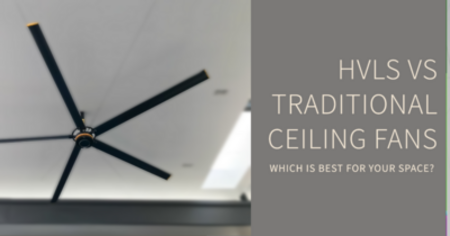When choosing the right type of fan for your space, the decision often boils down to HVLS (High Volume, Low Speed) or traditional ceiling fans. Both options serve the purpose of circulating air but differ significantly in design, functionality, and performance. This article will compare HVLS and traditional ceiling fans, discussing their fundamental differences, benefits, and applications. By understanding the unique characteristics of each fan type, you can make an informed decision about which option is best suited for your specific space and requirements.
Size and Design
One of the primary distinctions between Best HVLS fans and traditional ceiling fans is their size and design. Traditional ceiling fans typically have smaller blade spans ranging from 30 to 60 inches, making them suitable for residential or small commercial spaces. In contrast, HVLS fans are specifically designed for larger areas, with blade spans ranging from 7 to 24 feet. Their impressive size allows them to move large volumes of air at a low rotational speed, ensuring adequate airflow and circulation in expansive spaces such as warehouses, factories, gymnasiums, and airports.
Air Movement and Coverage
HVLS fans excel in terms of air movement and coverage. Their larger blades generate a slow, gentle breeze that creates a column of air beneath the fan. As the air reaches the floor, it spreads horizontally in all directions, creating a comfortable airflow throughout the space. This widespread air movement helps regulate temperature, eliminate hot and cold spots, and improve occupant comfort. HVLS fans can cover vast areas, ensuring consistent airflow even in spaces with high ceilings or irregular layouts.
Traditional ceiling fans, on the other hand, are designed for localized air circulation. They create a more focused breeze directly beneath the fan, providing targeted cooling in specific areas. At the same time, they may cover less ground than HVLS fans. Traditional ceiling fans are ideal for smaller rooms, bedrooms, offices, or restaurants, where concentrated airflow is desired.
Energy Efficiency and Cost Savings
Energy efficiency is a crucial consideration for any fan installation. HVLS fans are renowned for their exceptional energy efficiency, thanks to their low-speed operation and large blade size. The slow rotational speed consumes less electricity while delivering high volumes of airflow. In comparison, traditional ceiling fans typically operate at higher speeds to generate the desired breeze, resulting in higher energy consumption. The energy savings HVLS fans offer can be particularly significant in large spaces, where multiple traditional ceiling fans would be required to achieve similar airflow.
Furthermore, the reduced energy consumption of HVLS fans translates into substantial cost savings over time. Businesses and commercial establishments that opt for HVLS fans can experience a noticeable reduction in their energy bills, contributing to long-term financial savings and sustainability efforts.
Noise Levels
Another aspect to consider is the noise levels produced by the fan. Traditional ceiling fans, especially those with multiple blades, can sometimes generate noticeable noise as they operate at higher speeds. This can be a concern, particularly in quiet environments such as libraries, conference rooms, or bedrooms.
In contrast, HVLS fans are designed to operate silently. Due to their larger blades and slower rotation, they produce minimal noise, creating a peaceful and comfortable environment for occupants. This makes HVLS fans suitable for applications where noise reduction is a priority, such as offices, schools, or healthcare facilities.
Installation and Maintenance
Installing and maintaining fans can be a significant factor in the decision-making process. Traditional ceiling fans are relatively straightforward to install, and they typically come with mounting hardware and instructions for a hassle-free setup. However, if you have a space with a high ceiling or complex architecture, professional installation may be required.
Given their larger size and specialized installation requirements, HVLS fans often require professional assistance during the setup process. However, once installed, HVLS fans generally require minimal maintenance. Their robust construction and durable components make them a long-term investment with minimal upkeep needs, reducing the overall maintenance costs compared to traditional ceiling fans.
Conclusion
In the battle between HVLS and traditional ceiling fans, the right choice depends on your specific space, requirements, and priorities. If you have ample industrial or commercial space, HVLS fans offer superior air movement, energy efficiency, and coverage. On the other hand, traditional ceiling fans are well-suited for smaller rooms or residential settings, providing localized airflow and easier installation.
By considering factors such as size, design, air movement, energy efficiency, noise levels, and installation requirements, you can determine the ideal fan type for your space. Whether you choose HVLS fans or traditional ceiling fans, both options can contribute to enhanced comfort, improved airflow, and a more pleasant environment for the occupants of your space.




